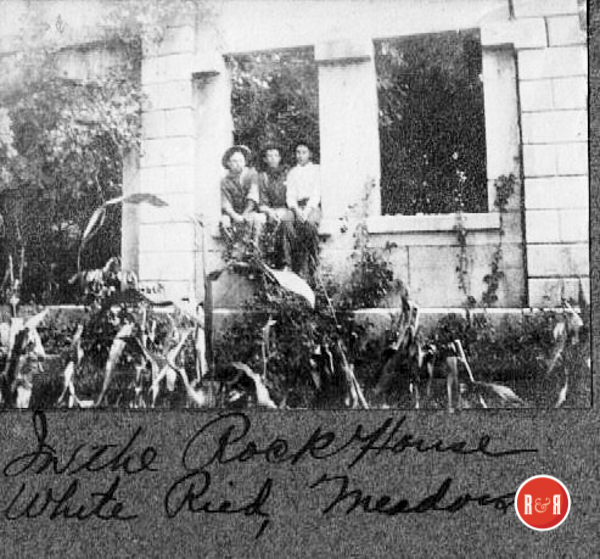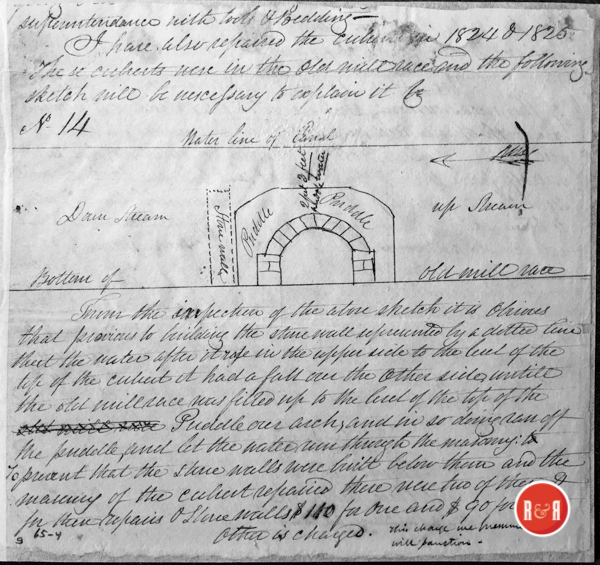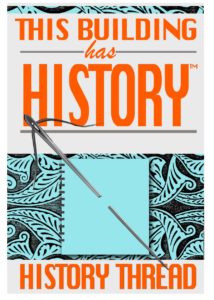“Charleston’s 19th century merchants wanted to capture the economic traffic from the upcountry.”
City Directories and History: “The name Land’s Ford, was derived from a grant in 1754 to Thomas Land of a tract containing an ancient ford. This rocky ford was an important crossing for Scotch-lrish settlers who traveled overland in wagons from Pennsylvania and settled in Chester County in the 1750’s and 1760’s. The site was also a campsite for forces under General Thomas Sumter and General William Richardson Davie. It was here where Cornwallis retreated across the ford from Charlotte to Winnsboro. In 1805, General Davie, Revolutionary Patriot, built his home overlooking Landsford, and also constructed a mill on the river. In 1822, he gave the land for the construction of the canal. His mill race was deepened and widened and was used as the upper end of the canal. Today, the walls of Davie’s mill and the rock dam over the river still remain.”

This Daniel Green Stinson sketch of Landsford crossing incorrectly places Thomas Larid’s home on the Lancaster County side of the Catawba River. Land was a Chester County resident. Henry Izard’s mill was most likely on the same site as General James Blair’s old mill. About the mill, Mary Izard wrote in 1815, “he… [her son, Henry] is now spending a great deal of money in building a merchant mill here… ” and, in another letter, “… he is much taken up with his mill and his cotton machine, which works with water… his Mill is well attended as is his cotton Gin.” Drawing copied from original in Draper Manuscripts by Joe H. Croxton, courtesy of Mrs. Joe H. Croxton / Courtesy of the Lancaster County Pictorial History by Bishop and Pettus, 1984
The S.C. Dept. of Archives and History sites is a great place to start your tour of the Canal.
Historically, the Landsford Canal, completed about 1823, was an important transportation link for about fifteen years. The immediate area was involved in military movement from the Revolutionary War through the Civil War. The canal remains as the only canal existing in its entirety without encroachment in the state. The Canal parallels a two-mile section of the Catawba River. As part of the inland navigation system from the Up Country to Charleston, a series of Catawba canals were begun in 1819 and completed several years later. Landsford Canal, the highest in the system, was built by engineer Leckie. Within this section, the River falls thirty-four feet. The Canal consists of three sets of locks, a mill site, miller’s house, and a lockkeeper’s house—all in various forms of decay and ruins. The tract, including an aboriginal ford, was granted to Thomas Land in 1754, thus the derivation of its name. Listed in the National Register December 3, 1969. (SC Dept. of Archives and History)
Local farmers often refused the services of their slaves for employment in building the canals, often suggesting, “Hire the Irish.” They felt their investment in slaves were to valuable for them to be harmed in state construction projects.
The Yorkville Enquirer of Feb. 21, 1878 reported – “A bill providing for a charter for the Landsford Manufacturing Co., has passed the house and is pending in the State House.”
The Rock Hill Herald reported on Feb. 5, 1880 – “A colored girl, the daughter of Peter Culp, was burned to death near Friedheim’s Store at Landsford in Chester County.”
“The RH Herald reported on Feb. 24, 1881 – Contained a letter for investors who are working for the erection of a cotton factory at Landsford. The men include: Capt. Allen Jones and Dr. T.C. Robertson both of Rock Hill are part of a group also Col. W.R. Davie of Landsford and Col. Edward McCrady of Charleston, S.C. The waterpower at Landsford is considered the best in the state. The fall there is 35 ft in 2,500 yrds. The country surrounding Landsford is level and fertile and could produce thousands of bales of cotton. The men propose raising a two story factory according to plans in the offices of Jones and Robertson.”
The Yorkville Enquirer reported on Aug. 4, 1886 – “Mr. Sam Friedheim of Landsford in Chester Co., was in Rock Hill today. He reports his tobacco crop is in a splendid condition.”
The Rock Hill Herald reported on Feb. 22, 1893 – “The Indianoa Manuf. and Power Co., the corporation that proposes to develop the waterpower at Landsford, will organize in early March and has a planned capital stock of $500,000. The propose to build a canal 1.25 miles in length and will provide water power for seven mill, each with 30,000 spindles. The place is favorable for a village.”
The Yorkville Enquirer reported on Oct. 24, 1894 – “The subscription for capital stock of the Landsford Water and Power Co., were opened in Rock Hill. The entire capital stock of $50,000. was subscribed at once mostly by citizens of Rock Hill.”
The Herald reported on Sept. 9, 1896 – “Samuel Friedheim has returned from the North where he has been buying goods for his store at Landsford.”
The Herald reported on May 3, 1899 – “At a Clerk of Courts sale, 89 shares of stock of the Landsford Water Power Company were sold at auction to R.L. Kerr and the National Union Bank.”
The RH Herald reported on June 16, 1900 – “The Lancaster Cotton Mill will be increased in size from 12,000 spindles to 62,000 spindles and from 500 looms to 1,590 looms. The present mill building will be greatly enlarged. Colonel Springs is the chief promoter of this scheme and is said to have already purchased most of the machinery. This project will make Lancaster one of the leading manufacturing cities in the state. It is proposed to power the machinery by a new company at or near Landsford on the Catawba River.”
The Herald reported on June 27, 1900 – “Col. LeRoy Springs of Lancaster and a group of northern capitalist have almost completed arrangements to build a huge dam across the Catawba River at Landsford and build a large electric plant to be used in supplying power to the factories of Lancaster and other towns. By this means the excellent water power at Landsford, which has been running to waste for centuries, will be harnessed by American genius and used to propel the wheels of the machinery in great manufacturing establishments.”
On July 25, 1900 the Herald reported – “The work is about to commonsense on the enlargement of the cotton mill at Lancaster. A contract for 4 million brick has been awarded to Mr. Tanner of Charlotte. The mill will be run by electricity from a new dam at Landsford, which could also supply all of Lancaster, Rock Hill and Chester.”
The Herald reported on Nov. 28, 1900 – “Mr. George E. Ladshaw and his brother T.D. Ladshaw, civil and hydraulic engineers of Spartanburg, are surveying Col. Spring’s Landsford Power and Water site. They will prepare plans for the dam and electric plant.”
The Herald on April 27, 1901 – Reporting on a court case of John R. London verses the Landsford Power Company. “Major London sued for $2,000. as reimbursement for five years service as Pres. of the company. The company claimed that Major London was to have served without compensation. The jury awarded Major London, $1,054.57.”
The South Carolina Board of Public Works contracted with Robert Leckie, a native of Scotland, to build the Landsford Canal in 1820. Leckie, an engineer and master stonemason, supervised the building of the Landsford Canal, and after 153 years the stone and rock work is some of the best preserved in the United States. The Canal reflects the skills of the 19th century artisans who built it.

Courtesy of the Gettys Collection. Image taken in ca. 1910…
The keystone on the arched bridge over the locks gives the name “Robert Leckie, Contractor, 1823.” This was the date Leckie reported the canal completed. The Landsford arched bridge is an artistic combination of cut stone, and field rock. Leckie also constructed the Court House at York, South Carolina; the arsenal at Fayetteville, North Carolina; and the walls of the Botanical Gardens in Washington, D.C.
(Information in part from: Chester County Heritage Book, Vol. I, Edt. by Collins – Knox, Published by the Chester Co Hist. Society – Jostens Printing, 1982)
See additional data under More Information > found under the images column.
Historian Harvey S. Teal’s Post Office Data in S.C., states: “The Landsford PO was started in ca. 1811 and ran until the Civil War. Hyder A. Davie served as the first Postmaster.”
Stay Connected
Explore history, houses, and stories across S.C. Your membership provides you with updates on regional topics, information on historic research, preservation, and monthly feature articles. But remember R&R wants to hear from you and assist in preserving your own family genealogy and memorabilia.
Visit the Southern Queries – Forum to receive assistance in answering questions, discuss genealogy, and enjoy exploring preservation topics with other members. Also listed are several history and genealogical researchers for hire.
User comments welcome — post at the bottom of this page.
Please enjoy this structure and all those listed in Roots and Recall. But remember each is private property. So view them from a distance or from a

Constructed at Dearborn Island by John McCullough and later moved to Landsford Park. Courtesy of the Pettus Archives and Winthrop University – 2014.

Early image of the bridge at Landsford State Park. Rock Hillian, Mr. Bob Ward, a local attorney saved the inscribed cornerstone from vandals and saw that it was restored to the bridge during restoration.
public area such as the sidewalk or public road.
Do you have information to share and preserve? Family, school, church, or other older photos and stories are welcome. Send them digitally through the “Share Your Story” link, so they too might be posted on Roots and Recall.
User comments always welcome - please post at the bottom of this page.

















Share Your Comments & Feedback: